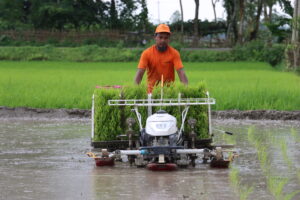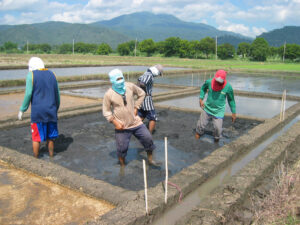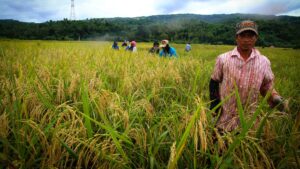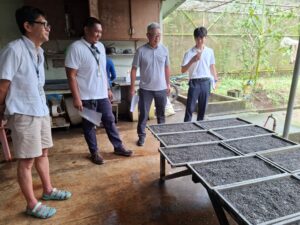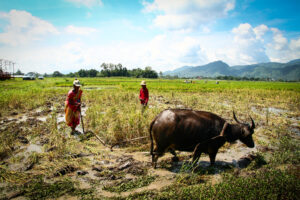by Swati Nayak, Muhammad Ashraful Habib, Kuntal Das, Saidul Islam, et al.
The adoption of stress-tolerant versions of popular rice cultivars can enable farming communities to mitigate the current and future challenges of recurrent flooding and drought in Bangladesh. It is recommended to promote these varieties on a large scale with assured availability and supply of good-quality labeled seeds through public and private extension and delivery networks. This remains critical to maintaining and increasing the rice production rate of the country to match the demand of the growing population.
Abiotic stresses such as droughts and floods significantly constrain rice production in Bangladesh. One of the most significant recurring challenges to rice productivity in the rainfed lowlands of Southeast and South Asia is flash floods that lead to the submergence of plants for more than ten days. In Bangladesh, major setbacks to the realization of potential yield are abiotic stresses such as flooding (50%), drought (20%), and salinity (30%).
Drought occurs mainly due to low and erratic rainfall. The north-western part of Bangladesh is considered a drought-prone area. Approximately 5.7 million ha of rice are grown under rainfed conditions that cause substantial yield decreases. Drought affects rice crops in more than one growth stage, for example, in the post-transplantation and establishment stages (early-phase drought) or in transplanted Aman (T. Aman: rainfed lowland rice), in which the crop is affected in the reproductive stage (terminal drought), resulting in considerable yield loss. Upland rice (aus) also suffers from drought as the crop is direct-seeded and grown under rainfed conditions.
Bangladesh, the seventh most- affected country by extreme weather events, saw 191 such occurrences from 1999 to 2018. According to government assessments in 2017, about 16,000 ha of farmland were fully lost and 560,000 ha of standing crops were partially damaged. Although data based on a comprehensive evaluation of the August 2017 flood-affected food crops are unavailable, Aman rice in low-lying areas was probably the most affected. In addition to drought, Bangladesh has the largest rainfed crop ecosystem; it too is prone to submergence.
Farmers in Bangladesh cultivate varieties such as BR10, BR11, and Swarna that have duration greater than 145 days as well as shorter duration varieties (<135 days) such as Binadhan-7, BRRI dhan39, and BRRI dhan49. These varieties are preferred because of their suitability, availability, high market value, high yield, and desired grain quality.
Cultivars that are susceptible to drought and submergence suffer yield loss due to recurring climatic hazards every year. With the recent innovations achieved through research in plant breeding, several climate-resilient varieties are available that can withstand climatic shocks and enable farmers to harvest a reasonable economic yield compared with conventional susceptible cultivars. Even though older varieties are capable of resisting floods to some extent, they are characterized by inferior grain quality and lower yields.
Additionally, in a few regions, farmers have abandoned rice cultivation, leaving their lands fallow during the rainy season. To offset the impact of submergence, the introduction of genes for submergence tolerance into high-yielding cultivars has proven to be the most impactful solution. Since these flood and drought spells occur every year, a variety should possess the basic trait of climatic resiliency in addition to other agronomic qualities, including yield.
In past studies on climate-ready crops, different outcomes showed positive, negative, and even indifferent impacts of various genes integrated into different crop species. However, a good understanding of the powerful influence of the submergence-tolerant quantitative trait locus (QTL) named Sub1 on yield, as well as yield-related metrics in farmers’ fields with no stress, is not available.
Through head-to-head trials, we assessed the effects of the Sub1 QTL integrated into various genetic backgrounds, such as BRRI dhan52 (BR11-Sub1) and BRRI dhan51 (Swarna-Sub1), on rice grain yield under non-submergence conditions in different locations over the years.
Our study also evaluated drought-tolerant varieties such as BRRI dhan71 and BRRI dhan56 and compared them with Binadhan-7 and BRRI dhan39 in 2018. As a unique on-farm trial method in farmers’ fields, head-to-head trials were used, which allowed growers to compare submergence and drought-tolerant varieties cultivated side by side with popular cultivars of farmers’ choice under their own crop management practices.
This study had two major objectives. The first was to evaluate the yield advantages (or disadvantages) for the introduced climate-resilient varieties against the farmer-grown varieties under farmer management practices. The second objective was to understand the informal dissemination and adoption rates for the new varieties in the regions where they were introduced.
The study has clearly demonstrated the yield superiority of some of the new submergence and drought-tolerant varieties vis-à-vis the farmer-chosen varieties, even under non-stress conditions. A similar study conducted in India through a randomized control trial in 2012 and 2013 had included one drought-tolerant variety, Sahabhagi Dhan.
That study had affirmed as high as a 1.3 tons/ha yield loss happening under severe drought. However, that study was not able to generate enough evidence for the yield advantage of the drought-tolerant variety.
Our study has been able to generate substantial evidence for multiple new drought-tolerant varieties developed in Bangladesh. Our study demonstrated the overall yield advantages of drought-tolerant varieties BRRI dhan56 and BRRI dhan71.
Similar trends observed across the location observed yield advantages (LOYA) and the location estimated yield advantages ( LEYA) values also affirm these results. The average LOYA value of BRRI dhan56 was 6.56% and 17.67% in Panchagarh and Thakurgaon, respectively, which was close to the respective LEYA values of 6.38% and 17.34%. The LOYA and LEYA values of BRRI dhan56 in Natore-1 were 3.35% and 3.37%. The LOYA and LEYA values for BRRI dhan71 were 3.30% and 3.20%, respectively.
A previous study conducted on flood-tolerant rice variety Swarna-Sub1 in India showed that the variety decreases yield variability and provides yield advantages under flooding and no yield penalty under non-flood conditions. Our current study has further included two new Sub1 varieties, BRRI dhan51 and BRRI dhan52.
In addition, our study suggests the yield superiority of both drought- and flood-tolerant germplasm even under non-stress conditions. The average yield advantages of BRRI dhan56, BRRI dhan71, BRRI dhan51, and BRRI dhan52 were 4.87%, 3.20%, 14.12%, and 10.21%, respectively.
The tolerant varieties with the Sub1 gene could survive complete submergence, in contrast with farmer varieties, and this can be attributed to the minimum shoot elongation of tolerant varieties underwater to reserve energy resources for maintenance of metabolism and for use during the recovery phase after the water recedes.
These newly developed varieties also strongly indicate the impact of breeding programs led by institutions such as BRRI and BINA being able to provide climate-resilient rice varieties with high genetic gain potential. One of the major arguments regarding the limited acceptance of climate-resilient varieties in various countries has been their inability to compete with farmer-chosen varieties under non-stress conditions and failing to considerably influence adoption behavior. However, superior germplasm providing assured and visible yield advantages has tremendous potential to change the scenario of varietal replacement.
Our study also established the higher adoption potential of the new resilient varieties. The new varieties were also significantly disseminated and adopted in the subsequent years after their introduction through on-farm trials. This can be credited to the superior performance of the varieties but also indicate how the learnings and awareness have not been limited to only the host farmers who participated in the on-farm trials.
The multiple PRA events organized in the same villages affirmed the rapid dissemination of farm-saved seeds through a community network and the adoption of the varieties by neighbor farmers. The adoption rate varied from 15% to 96%, with the average adoption rate of BRRI dhan51, BRRI dhan52, and BRRI dhan71 being 29.13%, 28.83%, and 76%, respectively.
Since the adoption rate in our study was also highly satisfactory within the participating villages, it is recommended to promote these varieties on a large scale with assured availability and supply of good-quality labeled seeds through public and private extension and delivery networks. The adoption of stress-tolerant versions of popular rice cultivars can enable farming communities to mitigate the current and future challenges of recurrent flooding and drought in Bangladesh.
This remains critical to maintaining and increasing the rice production rate of the country to match the demand of the growing population. Therefore, it is imperative to appropriately position these climate-resilient or stress-tolerant varieties against the popular non-stress-tolerant varieties.
This also calls for targeted public-private community partnerships in seed systems to accelerate the supply of early-generation as well as commercial and good-quality seed for faster varietal turnover.
Read the study:
Nayak S, Habib MA, Das K, Islam S, Hossain SM, Karmakar B, Fritsche Neto R, Bhosale S, Bhardwaj H, Singh S, Islam MR, Singh VK, Kohli A, Singh US, Hassan L. (2022) Adoption trend of climate-resilient rice varieties in Bangladesh. Sustainability 14, 5156.

